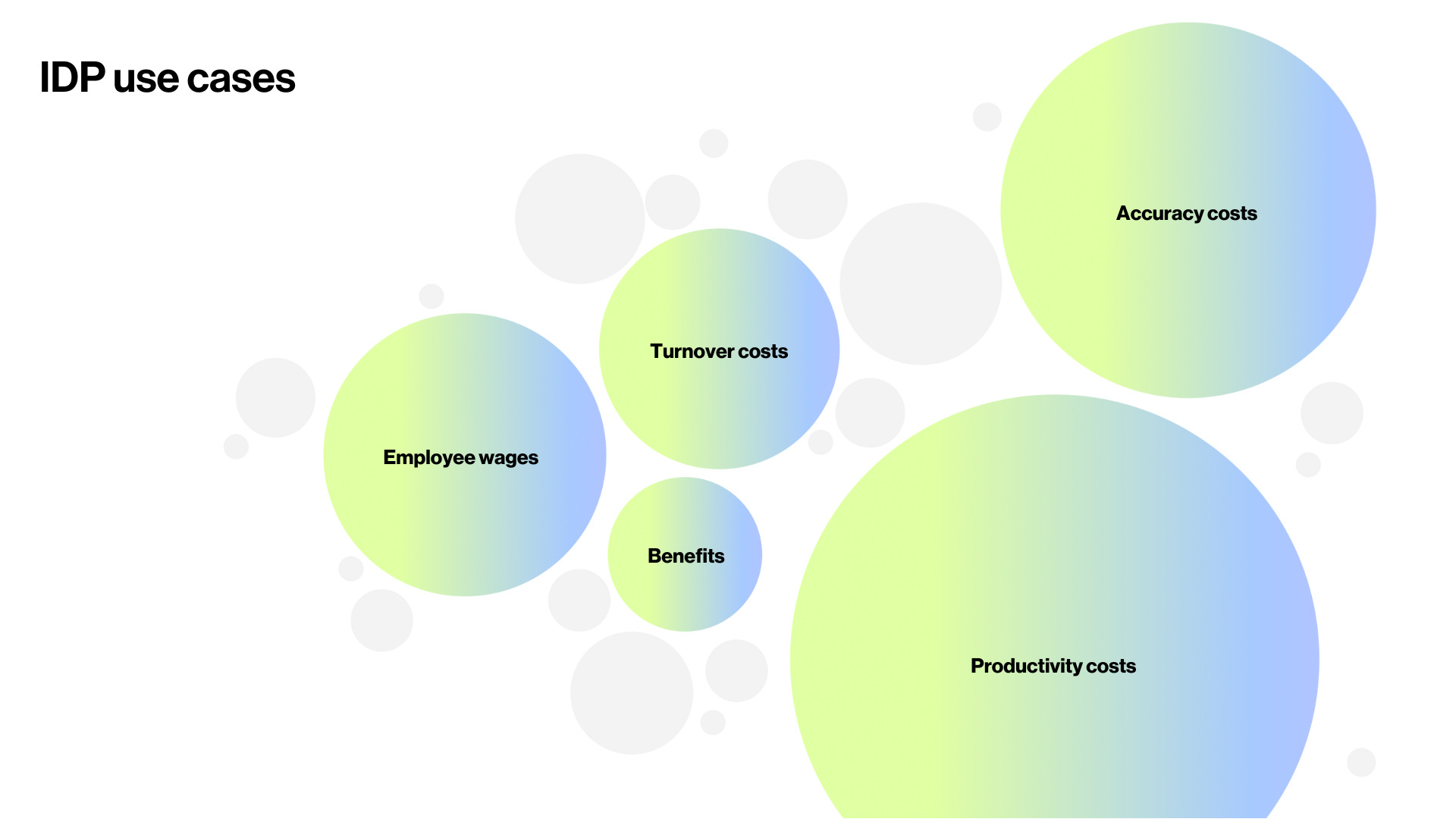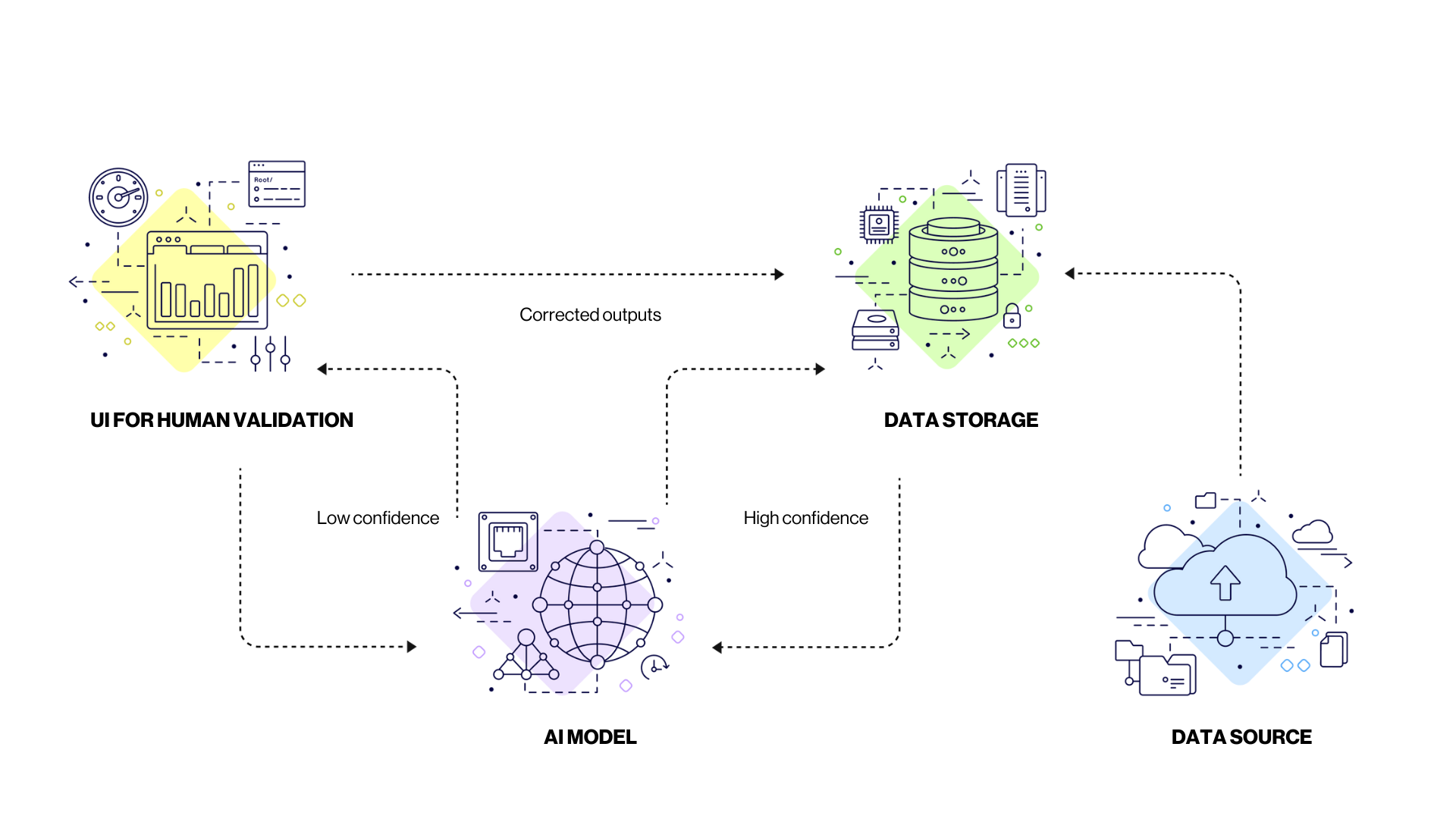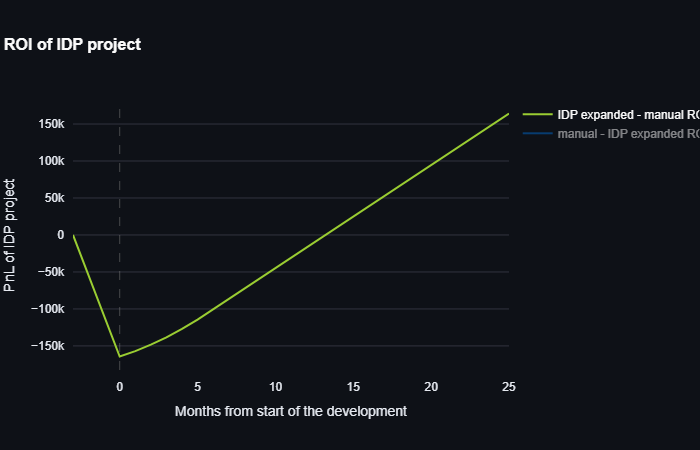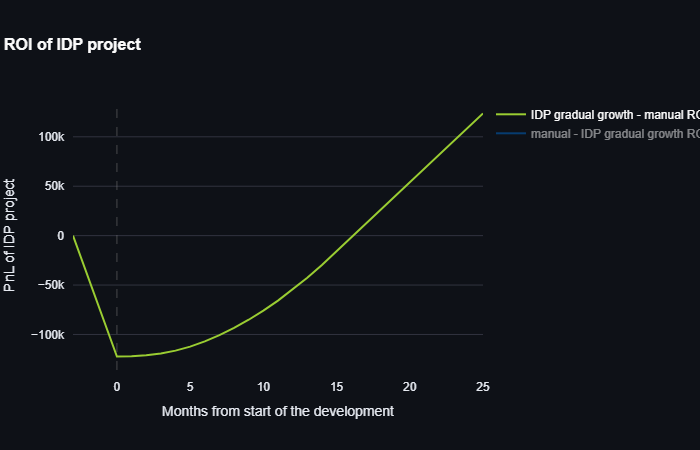 Written by Vlad Borysenko, Principal Data Scientist at Neurons Lab.
Written by Vlad Borysenko, Principal Data Scientist at Neurons Lab.
Manual document processing is tedious, expensive, and prone to human error. Yet many organizations continue using traditional systems that drain productivity. Intelligent document processing (IDP) solutions promise to alleviate these issues through automated data extraction, validation, and routing. However, before investing in this technology, it is fundamental to be able to evaluate IDP’s economic potential.
In this article, we’ll analyze the costs and possible ROI of implementing an IDP system. It will explore examples and use cases from two regions, North America and APAC, respectively, examining metrics such as processing costs, document turnaround, productivity costs, and ROI.
Whether you are considering initial IDP adoption or looking to maximize an existing deployment, this deep dive will uncover best practice calculations for using AI to unlock the full value in your organization’s documents.
Exploring Costs of Manual Document Processing
Hypothetical Example 1, USA
What exactly is the return on investment (ROI) of implementing an IDP system? First, let’s examine the baseline costs of relying on manual document processing, which typically consists of time-intensive data entry and document review by employees.
In the following example, I’ve taken approximate US-based figures to build a hypothetic use case, please be aware that figures and costs will vary according to each company’s individual needs. Key cost drivers include:
- Employee wages – Salary paid to workers manually entering data, reviewing documents, etc. Often paid on an hourly basis.
- Benefits – Added costs of providing health insurance, retirement plans and other benefits to employees, averaging 25-30% of wages.
- Turnover costs – Expenses associated with recruiting, hiring and training new workers to replace existing ones. Can often reach 150% of an employee’s annual salary.
- Accuracy costs – Manual processes lead to more errors which cost money to detect and correct. Some estimate error rates above 5%.
- Productivity costs – Time spent on manual document processing that could have been utilized for more strategic tasks.
When looked at more granularly across common business functions, the costs add up:
- Accounts Payable – AP clerk wage of $25/hr + benefits of $6.25/hr = $31.25/hr. Each invoice requires 5-10 mins to enter into system.
- Contracts – Paralegal wage of $30/hr + $7.50 benefits = $37.50/hr. Review and abstract key terms from 20-page contract in 60 mins.
- Onboarding – HR assistant wage of $18/hr + $4.50 benefits = $22.50/hr. Enter new hire info and file documents in 90 mins.
- Lending – Loan officer wage of $45/hr + $11.25 benefits = $56.25/hr. Review loan application supporting documents for 30 mins.
As you can see, even relatively short manual document processing times add up to major costs, especially for large organizations with thousands of documents being handled each week.

Human-in-the-loop
The aim of most of the IDP systems is to completely automate the process so that no time is spent by a person. Due to the process’ complexity it’s not always possible, especially at the initial stages of the system. In that case, the aim becomes to minimize the time spent by a person and make the process as easy as possible for them.
The person who interacts with the results of the IDP system is called human-in-the-loop (HIL). They are usually, but not necessarily, the same person who was doing the job manually before IDP system was introduced.
The effects IDP system has on the HIL in the process include:
- Reducing the time it takes to process one page/document/case. Instead of processing the document in its entirety, HIL just needs to review the results of processing and confirm them.
- Reducing the number of pages/documents/cases that need HIL’s attention. Over time, fewer and fewer documents will need to be reviewed as the system learns from its mistakes and from the corrections done by HIL.
All of the following calculations are based on this concept, though in more advanced systems scenarios, HIL involvement might be reduced to 0.

Calculating IDP Cost Savings
The costs above reveal the potential for automation using intelligent document processing. IDP software utilizes advanced AI and machine learning to automatically classify documents, extract and validate key fields of data, and route information through appropriate workflows.
Let’s analyze sample cost savings from the different business functions above when transitioning from manual to automated IDP-based document processing. We’ll assume the IDP solution implementation costs are $400,000, with $100,000 spent annually, including any licensing fees, IT support/maintenance, and allowances for incremental bandwidth and storage.
Accounts Payable
- 2,000 invoices processed weekly = 96,000 invoices annually
- 5 minutes per invoice manually at $31.25/hr labor cost
- Total manual processing cost = 96,000 x (5/60) x $31.25 = $250,000
- IDP solution handles 1000 invoices at the price of $65 → 96 x $65 = $6240
- HIL is required to check 20% of low-confidence processing results, and review time is 1 minute on average → 96,000 x 0.2 x $31.25 / 60 = $10,000
- Total Annual AP savings = $250,000 – $10,000 – $6,240 = $233,760
Contracts
- 500 contracts processed weekly = 24,000 annually. Each contract – a 20 page document on average.
- 60 minutes to review each at $37.50/hr rate
- Total manual cost = 24,000 x (60/60) x $37.50 = $900,000
- IDP solution handles 1000 pages at the price of $50 → 24*20 x $50 = $24,000
- HIL is required to check all results, but review time is 20 minutes on average → 24,000 x $37.5 x (20/60) = $300,000
- Total Contract savings = $900,000 – $24,000 – $300,000 = $576,000
Onboarding
- Average 50 new hires per month = 600 annually. Each hire – 5 documents with 10 pages to process on average.
- 90 mins per new hire at $22.50/hr costs $20,250
- IDP solution handles 1000 pages at the price of $50 → 600 x 5 x 10 x $50/1000 = $1,500
- HIL is required to check all results, but review time is 15 minutes on average → 600 x $22.5 x (15/60) = $3,375
- Total Onboarding savings = $20,250 – $1,500 – $3,375 = $15,375
Lending
- 1,200 loan applications annually, each application 10 pages on average
- 30 mins each at $56.25/hr costs $33,750
- IDP solution handles 1000 pages at the price of $100 → 1200 x 10 x $100/1000 = $1,200
- HIL is required to check all results, but review time is 10 minutes on average → 1200 x $56.25 x (10/60) = $11,250
- Total Lending savings = $33,750 – $1,200 – $11,250 = $21,300
Total IDP Annual Cost Savings = $846,435
As shown above, the cost savings from transitioning these common document processing workflows from manual data entry to an intelligent automation solution like IDP are substantial, even for a relatively small organization. The more documents and heavier reliance on manual processing, the greater the savings grow.
Calculating IDP Return on Investment
Now we have crunched the numbers on cost savings, let’s continue our analysis to calculate IDP ROI and payback period.
First, we’ll recap the key figures from our savings above:
IDP Solution Implementation Cost: $400,000 IDP Solution Cost: $100,000 annually Total Annual IDP Savings: $846,435
ROI = (Gain from Investment – Cost of Investment) / Cost of Investment
Plugging the data into the ROI formula, projecting over 3 years: ROI = ($846,435 x 3 – ($400,000 + $100,000 x 3)) / ($400,000 + $100,000 x 3) = = ($2,539,305 – $700,000) / $700,000 = 2,62x
An ROI above 2.0x means the investment is worthwhile, so achieving a 2.62x ROI indicates substantial returns from transitioning to automated IDP-based document processing.
We can also easily calculate the payback period, which is the amount of time required to recoup the investment costs:
Payback Period = Cost of Investment / Annual Savings
Here, it would take roughly 7 months for the IDP implementation costs to be paid back in full through cost savings:
Payback Period = ($400,000 + $100,000) / $846,435 per year = 0.59 years or ~7 months
A payback period measured in months rather than years further showcases why intelligent automation delivers such a fast, material ROI for organizations. The larger the rollout, the faster the investment pays for itself.
Strategies for Maximizing IDP ROI
We’ve seen the significant cost savings and impressive ROI possible from deploying intelligent document processing now here are three key strategies organizations should consider to maximize returns:
1. Prioritize high-volume workflows
As the numbers above illustrate, processes like Accounts Payable invoicing lend themselves extremely well to automation, with thousands of repetitive documents to process daily. Focus initial IDP solutions on these document types.
2. Phase deployments thoughtfully
While an enterprise-wide rollout might provide the largest ROI, a gradual deployment allows for pilots, training, and change management to smooth the transition. Target fixes first for known pain points.
3. Combine IDP with other intelligent technologies
Integrating IDP with chatbots, RPA, natural language processing and more creates an automation multiplier effect. The solutions build on each other for even greater gains.
Let’s look at an example from Neurons Lab
Example 2 Neurons Lab, APAC region
Neurons Lab collaborated with a partner in the APAC region that aims to process approximately 220,000 receipts per month for its 44 clients. The traditional manual approach to this task is not only labor-intensive but also fraught with hidden costs and risks.
To handle this volume of receipts, it would be necessary to employ a team equal to 46 FTE (full-time equivalent), given that the average processing time for each receipt is about 2 minutes. With a minimum wage of $320 the financial burden quickly adds up. The cost of 46 FTE needed to process these receipts manually results in a monthly expense of approximately $14,720.
Let’s consider that the expense of operating a cloud-based system to distribute tasks among the workers is $100 per month.
The manual solution is not just expensive; it’s also insecure due to high employee turnover, requires constant training for new hires, and is vulnerable to HR issues such as absenteeism. This model is unsustainable in the long run.
Scenarios Showcasing Savings
We’ve analyzed several scenarios to illustrate the cost savings our IDP solution offers. Please note that we include the cost of running of the manual (base) process during the implementation period in the implementation costs of the IDP solution.
Fully expanded scenario
In this scenario:
- the business is already working with 44 clients, as described above.
- our solution is gradually learning, and it’s percentage of high confidence predictions is increased gradually over 6 months from 0% to 90%.
- this means that from the moment the solution is integrated into the workflow, the number of employees needed is reduced to 23 FTE. This number will gradually lower down to 2.3 FTE in 6 months.
- Monthly cost for HIL review: $7,360 → $736, over 6 months period.

Result: Solution is profitable in 14 months after launch.
Starting from beginning scenario
In this scenario:
- same gradual confidence increase over 6 month from 0% to 90%, as in previous scenario.
- over 15 months, number of customers increases from 2 to 44.
- the number of customers only begins to grow once the solution is in place.

Result: Solution is profitable in 17 months after launch.
These scenarios demonstrate that the IDP solution becomes profitable relatively quickly and offers significant monthly savings compared to the manual processing method.
Question: Is there an optimal point in time, when it’s most cost-effective to make an investment into the solution’s development and integration?
Timing Is Everything: When to Invest in IDP
While it may seem intuitive to initiate the implementation of an IDP solution early on to reap benefits sooner, this is not always the case. Starting too early, when the client base is limited, can actually prolong the payoff period due to the initially low document volume. Our analysis indicates that there is a strategic moment for starting development that optimizes the payoff period.
Identifying the Optimal Investment Window
Determining the most advantageous time to invest in an IDP solution depends on two factors:
- The projected growth in document volume per month
- The existing quantity of documents processed monthly
Investing in an IDP solution is most beneficial when a significant increase in the number of documents is anticipated. This strategic timing ensures that the solution is ready to handle the increased workload, leading to faster payoff and greater cost savings. Notably, this significant increase in volume might only be possible, and is enabled in the first place due to IDP solution integration.
The current processing volume of documents also plays a role in the investment decision. To minimize the time to achieve a return on investment, it may be advantageous to postpone the investment until there is a sufficient volume of documents being processed. Considering the significant expense associated with IDP implementation, it is wise to consider IDP once the business is mature enough.
Fastest payoff period
- In our example, a faster payoff period of 13 months is achieved by starting solution development 3 months in, with monthly document volume of 55,000.
- In this case our solution is $1,833 up at the start of the month.
- The difference in projected profits at 24 months mark between the “early start” and “3 months delayed start” scenarios is $38,150.

- The “fastest” payoff period is achieved by delaying the development by 7 months, achieving 13 months payoff and $9,133 profit at the start of the month.
- Due to a cap on the projected number of clients, the payoff period starts to gradually lengthen after this point.
- The difference in projected profits at 24 months mark between the “early start” and “7 months delayed start” scenarios is $86,584.
- It is pretty clear that it is not worth to delay development this much. The document volume should be significant enough to warrant the investment 3 months in, if not earlier.
Wrapping things up
The operational efficiencies and cost savings made possible by intelligent document processing are too substantial to ignore. As the examples and ROI calculations above illustrate, IDP solutions offer a fast track to material productivity improvements and headcount cost reductions.
Of course, financial returns are only one part of the equation – enhanced data quality, improved compliance, superior customer experience and freed up employee time for strategic work are intangible yet vital IDP benefits as well.
With the stellar ROIs involved, organizations that fail to explore intelligent document processing run the risk of severely lagging behind competitors who have already added IDP to their automation arsenal. The numbers don’t lie – integrating this innovative technology should be a top priority for nearly any enterprise today.
How can Neurons Lab support
Neurons Lab is an AI consultancy that provides end-to-end services – from identifying high-impact AI applications to integrating and scaling the technology. We empower companies to capitalize on AI’s capabilities.
With IDP amongst our top technical capabilities, we enable you to enhance document-related processes with automated summary generation and decision-making recommendations, possessing expertise in OCR Suite, named entity recognition, document summarization, and document storing.
We worked with Treatline’s platform, for example, to leverage cutting-edge AI technology and AWS services in order to streamline the prior authorization process for insurance companies and healthcare providers. The platform comprises three main components: web app, Intelligent Document Processing, and the Generative AI criteria matching system.
Get in touch with the team here for your upcoming IDP-based project.









